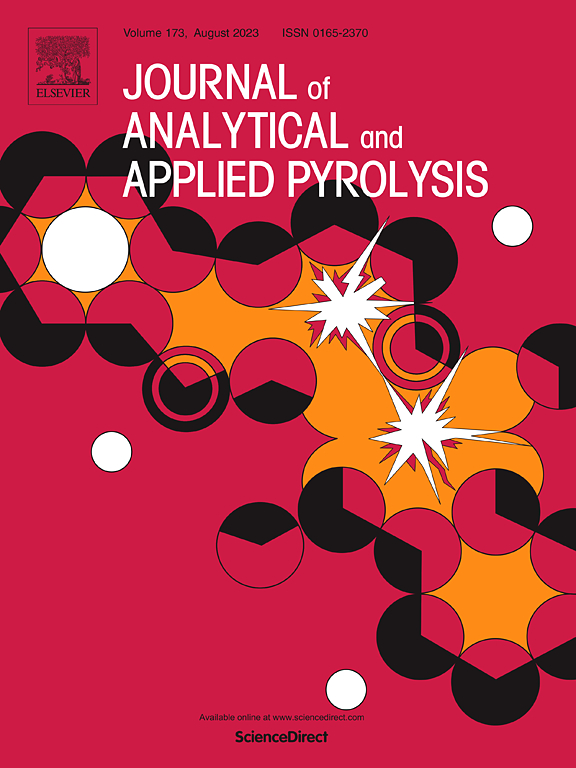Fe-Ni改性复合多孔分子筛催化小麦秸秆快速热解制备芳烃
IF 5.8
2区 化学
Q1 CHEMISTRY, ANALYTICAL
引用次数: 0
摘要
以260℃烘烤的麦秸(WS)为原料。通过碱处理(NaOH)和金属负载(Ni, Fe)对HZSM-5进行改性,然后在改性后的HZSM-5上引入MCM-41层,合成复合孔沸石。采用管式炉和Py-GC/MS研究了不同复合孔催化剂对WS催化快速热解(CFP)三相产物及生物油组分分布的影响。以1 %FeAZ@M为催化剂,生物油得率最高(31.31 %)。引入微介孔分子筛0.3AZ@M作为催化剂,WS CFP生物油中单环芳烃(MAHs)的选择性最高(52.12 %),生物油收率为26.50 %。金属修饰的复合孔沸石具有增强的酸性,可以进一步改善生物油中组分的分布。使用1 %NiAZ@M作为催化剂,CFP WS生物油中MAHs的产量最高(60.67 %),生物油收率为23.27 %。双金属改性复合孔分子筛中,1 %Ni1 %FeAZ@M对MAHs的选择性最高,生物油中MAHs的选择性达到66.36 %,生物油收率提高到28.41 %。本文章由计算机程序翻译,如有差异,请以英文原文为准。
Fast pyrolysis of baked wheat straw catalyzed by Fe-Ni modified composite porous molecular sieves for the preparation of aromatics
Wheat straw (WS) baked at 260°C is used as raw material. The HZSM-5 was modified through alkali treatment (NaOH) and metal loading (Ni, Fe), followed by the introduction of MCM-41 layers onto the modified HZSM-5 to synthesize composite pore zeolites. A tubular furnace and Py-GC/MS were used to investigate the effects of different composite pore catalysts on the three-phase products and the distribution of bio-oil components during the catalytic fast pyrolysis(CFP) of WS. The use of 1 %FeAZ@M as a catalyst achieved the highest bio-oil yield (31.31 %). Introducing the micro-meso composite pore zeolite 0.3AZ@M as a catalyst resulted in the highest selectivity of monocyclic aromatic hydrocarbons (MAHs) in the bio-oil from WS CFP (52.12 %), along with a bio-oil yield of 26.50 %. The metal-modified composite pore zeolites exhibit enhanced acidity, which can further enhance the composition distribution in the bio-oil. The use of 1 %NiAZ@M as a catalyst resulted in the highest production of MAHs in the bio-oil from WS of CFP (60.67 %), with a bio-oil yield of 23.27 %. Among the bimetal-modified composite pore zeolites, 1 %Ni1 %FeAZ@M demonstrated the highest selectivity for MAHs, with MAHs in the bio-oil reaching 66.36 %, while the bio-oil yield increased to 28.41 %.
求助全文
通过发布文献求助,成功后即可免费获取论文全文。
去求助
来源期刊
CiteScore
9.10
自引率
11.70%
发文量
340
审稿时长
44 days
期刊介绍:
The Journal of Analytical and Applied Pyrolysis (JAAP) is devoted to the publication of papers dealing with innovative applications of pyrolysis processes, the characterization of products related to pyrolysis reactions, and investigations of reaction mechanism. To be considered by JAAP, a manuscript should present significant progress in these topics. The novelty must be satisfactorily argued in the cover letter. A manuscript with a cover letter to the editor not addressing the novelty is likely to be rejected without review.

 求助内容:
求助内容: 应助结果提醒方式:
应助结果提醒方式:


